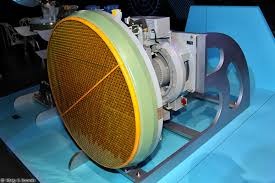Pulse Doppler Radar
Fact for 8/7/2021
FACTS
Pulse radar emits short and powerful pulses and in the silent period receives the echo signals. In contrast to the continuous wave radar, the transmitter is turned off before the measurement is finished. This method is characterized by radar pulse modulation with very short transmission pulses The distance of the reflecting objects is determined by runtime measurement (at a fixed radar) or by comparison of the characteristic changes of the Doppler spectrum with the values for given distances stored in a database (for radar on a fast-moving platform). Pulse radars are mostly designed for long distances and transmit a relatively high pulse power.




Important distinguishing feature to other radar method is the necessary time control of all processes inside the pulse radar. The leading edge of the transmitted pulse is the time reference for the runtime measurement. It ends with the transition of the rising edge of the echo signal in the pulse top. Systematic delays in signal processing must be corrected when calculating the distance. Random deviations influence the accuracy of the pulse radar The construction of a pulse radar depends on whether transmitter and receiver are at the same site (monostatic radar) or whether both components are deployed at completely different locations (bistatic radar).


A monostatic pulse radar, in addition to the compact design has the advantage that the important for pulse radars timing devices can be concentrated in a central synchronization block. Internal runtimes of the radar triggers can thus be kept low. An elaborate radar antenna can be used by means of a multiplexer for both transmitting and receiving.
The disadvantage is that often the highly sensitive radar receiver must be switched off by a duplexer for its own protection against the high transmission power. During this time it cannot receive anything. In a bistatic pulse radar, the receiver is equipped with its own antenna in a different location as the transmitter. This has the advantage that the receiver can operate without significant protective measures against to a high transmission power. In the simplest case, a network is constructed from extra receiver locations to an existing monostatic pulse radar. The receiving antennas are not very directionally: they must be able to receive from several directions simultaneously. The disadvantage here is the very complex synchronization. Simultaneously with the echo signals, the receiver must also receive the direct transmission signal. From this signal and the known distance to the transmitter, a sync signal must be generated. Principal military application of bistatic configurations are the Over-The-Horizon (OTH) Radars.
The passive radars are a variant of the bistatic radar. They parasitically use a variety of RF emissions (radio or television stations, or external pulse radars) The passive radar calculates the position of the targets from the difference between the time of the direct path of the signal and the additional running time of the reflected echo signals. Ambiguities in the measurement can be excluded on the one hand by direct direction finding involving spurious emissions of the target or by synchronization of two passive radars working at different locations.
Source - radartutorial.eu
